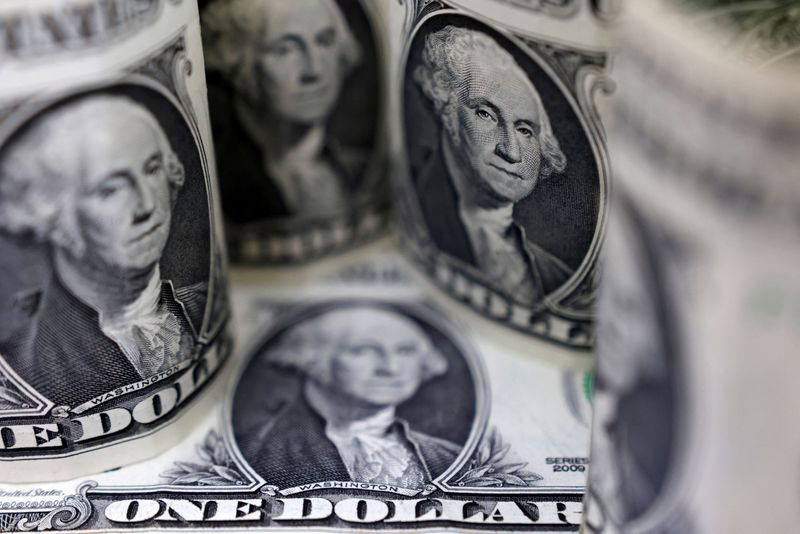Forex
Dollar hits 4-week peak, sterling lower after BOE hike


© Reuters. FILE PHOTO: U.S. Dollar banknotes are seen in this illustration taken July 17, 2022. REUTERS/Dado Ruvic/Illustration
By Samuel Indyk and Rae Wee
LONDON (Reuters) – The dollar touched a four-week peak against major peers on Thursday after upbeat labour market data a day earlier, while sterling remained lower after the Bank of England downshifted to a smaller 25 basis point hike.
Data out on Wednesday showed U.S. private payrolls rose more than expected in July, while plans by the U.S. Treasury to increase the size of government bond auctions in the third quarter pushed longer-dated U.S. Treasury yields higher and boosted the dollar.
“In a world where the U.S. continues to perform and avoids a hard landing while the rest of the world is struggling, it’s an environment which is going to keep the dollar elevated,” Barclays (LON:) FX strategist Lefteris Farmakis said.
The , which measures the currency against six major peers, rose as high as 102.84, its highest level in four weeks. It was last little changed at 102.60, after Wednesday’s 0.5% gain.
The closely watched U.S. nonfarm payrolls report is due on Friday.
A fresh wave of risk aversion after rating agency Fitch downgraded the U.S. government’s top credit rating could have resulted in some safe-haven buying, others said, which paradoxically also lent support to the dollar.
Sterling meanwhile fell as much as 0.7% to $1.2620, its lowest level since June 30 after the BOE opted to raise its key bank rate by 25 basis points, following an unexpected half-point move in June.
“The relative disparity in the trajectory of future monetary policy, against a backdrop of better-than-expected economic growth data, has catalysed a rally in the UK pound this year,” said John Leiper, Chief Investment Officer at Titan Asset Management.
“But momentum has dwindled recently, following the latest inflation number … and signs today that the bank is becoming a little more relaxed around the direction of travel.”
The pound was last down 0.3% at $1.2676.
The safe-haven yen was last nearly 0.3% higher at 142.87 per dollar, benefiting from risk aversion as global equities extended their recent drop. Earlier, the currency fell to a four-week low of 143.89 per dollar.
The Japanese currency had come under pressure this week even as the Bank of Japan on Friday loosened its grip on interest rates. Policymakers have also been quick to push back against speculation that the move was a prelude to an imminent exit of the central bank’s ultra-easy policy.
The euro was up 0.1% at $1.0946, while the fell to a two-month low of $0.6514.
The New Zealand dollar similarly earlier slid to its lowest since end-June at $0.6063, having tumbled more than 1% on Wednesday.
“Risk assets have been more impacted by the Fitch downgrade,” Tina Teng, market analyst at CMC Markets, said. “The U.S. dollar actually strengthened against most other currencies (and) there were risk-aversion trades across all the asset classes.”
Elsewhere in Asia, China’s strengthened after data on Thursday showed that the country’s services activity expanded at a slightly faster pace in July, though investors continue to be on the lookout for further support measures from Beijing following last week’s Politburo meeting.

 Forex3 years ago
Forex3 years agoForex Today: the dollar is gaining strength amid gloomy sentiment at the start of the Fed’s week

 Forex3 years ago
Forex3 years agoUnbiased review of Pocket Option broker

 Forex3 years ago
Forex3 years agoDollar to pound sterling exchange rate today: Pound plummeted to its lowest since 1985

 Forex3 years ago
Forex3 years agoHow is the Australian dollar doing today?

 Cryptocurrency3 years ago
Cryptocurrency3 years agoWhat happened in the crypto market – current events today

 World3 years ago
World3 years agoWhy are modern video games an art form?

 Commodities3 years ago
Commodities3 years agoCopper continues to fall in price on expectations of lower demand in China

 Economy3 years ago
Economy3 years agoCrude oil tankers double in price due to EU anti-Russian sanctions





















